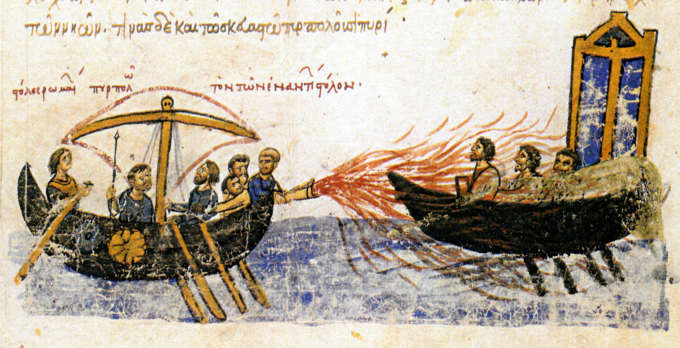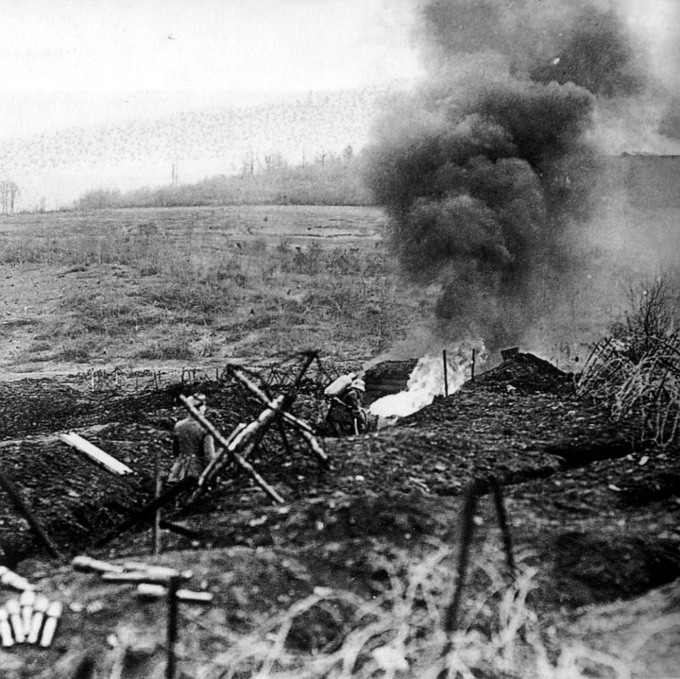Planes, tanks and ships all have their ways to set things on fire. One of them is to use weapons such as flamethrowers or incendiary bombs. Read more about them — in this article.
Incendiary bombs
Incendiary bombs are best used to destroy open-topped vehicles (literally to burn them down) where the incendiary mixture will make sure exposed crews will be knocked out and possibly light up the engine of vehicles due to its extreme temperature. While some players consider it has more aesthetic use than in practical use, it can also block Night Vision Devices and serve as a makeshift "smoke grenade" for tanks and help them hide from enemy eyesight for a while. Alternatively, this could be used like general purpose bombs and burn down enemy bases/airfield if needed, though with a lower effectiveness per payload mass then the general-purpose bombs.
Flamethrowers
The Flamethrower is a fire-based weapon added in Update "Fire and Ice" with rewards in the Battle Pass: Season IX, "Smell of Victory". These usually have a relatively short range with the ability to damage open-topped vehicles.
Vehicles equipped with this weapon
Ground Vehicles
- TO-55 - The flamethrower on the USSR TO-55 has a onboard fuel supply and the coaxial flamethrower is on the turret.
- Churchill Crocodile - The flamethrower on the Churchill Crocodile consists of a fuel trailer towed behind the tank and a flame projector in the bow gun position.
Naval Vehicles
- LCM(6) Zippo - The LCM(6)(F) Zippo has two flamethrowers on the port and starboard sides behind the 40 mm gun turret. This weapon system has fuel tanks located in the hull and projectors in small combined turrets paired with 7.62 mm M73 machine guns.
Ammunition
Flamethrowers use ignited liquid fuel as ammunition, usually consisting of a mixture of napalm similar to that used in incendiary bombs such as the BLU-1. The Churchill Crocodile uses a mixture called Fuel K, or FTF, Heavy No.1. There is currently no alternative fuel choices for the flamethrowers in-game.
As an unconventional ammunition type, burning fuel has no armor penetration values and will not damage the internal modules of a vehicle if it is fully armored or CBRN-secured. If a vehicle is open-topped or very lightly armored with gaps, the flamethrower can output a devastating amount of damage.
Flamethrowers output a type of damage that no other weapon system in the game can do, called Damage over Time. Ground areas, items, and enemy targets will continue to burn for a brief period after being hit. This can cause damage to the enemy even after the flamethrower has stopped firing.
History
The First World War saw the introduction of many horrifying new weapons of war. The tank, armed planes, submarines, poison gas shells, and more turned what was assumed to be a swift conflict into a four-year-long bloodbath. The Flamethrower was another weapon that made the War to End All Wars so costly. The modern flamethrower made its debut in World War I, but it is the perfection of a tactic that has existed for centuries.
Thermal weapons have existed for a very long time because of their recognized use against fortifications and enemy equipment. The earliest recorded example of what could be considered a flamethrower comes from the Ancient Greeks. During the Peloponnesian Wars, a wheeled siege weapon that shot fire was used by the Boeotians against the Athenians during the Battle of Delium in 424 B.C. This is the earliest recorded instance of a flamethrower-like weapon used in battle. Another early flamethrower is recorded in use by the Romans against the Dacians in 107 A.D. in a similar capacity to the Greek design centuries before.
More early flamethrowers would emerge when the Byzantine Empire invented Greek fire. The invention is credited to an architect and chemist named Kallinkinos of Heliopolis c.673. Greek fire was primarily used as a naval weapon, but land forces were recording what was dubbed a cheirosiphona (hand-held siphons) which resembled a modern flamethrower in form and function. The weapon was a hand-held pump that shot Greek fire from a tube in short bursts. Ignition was handled by a piston lighting a match as the fire was ejected.
Another early example worth noting is the Chinese Pen Huo Qi (fire spraying device) another piston flamethrower invented in 919 A.D. two years after the first documented example of Greek fire in China. This device used what was called Meong Hou You (lit. fierce fire oil, an early Chinese name for petroleum) as its flamethrowing agent. Ignition was achieved by gunpowder, the first time it was used in warfare by the Chinese. This application is shown by the first documented use of this weapon during the 919 Battle of Langshan Jiang where a slow-burning gunpowder match was used to ignite a continuous string of flame by Wuyue to burn their fleet, defeated the Kingdom of Wu in the process.
The modern flamethrower was invented in Germany before World War I. The name is a loanword from the German ‘Flamenwerfer’ coined during WWI. The original design came from Richard Fiedler, who showcased several designs to the Deutsches Heer (Imperial German Army) in 1901 with the most notable being a single-shot design that used a two-part cylinder that carried pressurized nitrogen and flammable oil that mixed when fired. Ignition was done with a simple wick and the weapon had a range of 20 yards. While not adopted, Fiedler improved on the design, and in 1908, he collaborated with German officer Bernard Redderman who demonstrated flamethrowers made from converted steam-powered fire engines the year before. The two men got the Deutsches Heer to test their new joint design with an experimental pioneer company for testing and the flamethrower was adopted in 1911. Despite being adopted before the outbreak of the war the Germans didn’t use it in combat initially. It was issued in limited numbers and first by German soldiers outside Verdun on February 26th, 1915.
It was on July 30th however, that the Germans recognized the true value of the flamethrower. That day saw a concentrated flamethrower attack on British trenches at Hooges, Belgium. The British suffered significant casualties with 31 officers and 751 other soldiers after two days thanks in part to the flamethrower flushing soldiers out and forcing them into the gunfire of supporting units. The flamethrower was adopted on all fronts, and the Germans used it in more than 650 attacks. The design was also gradually copied by the Entente. The first use of a flamethrower on a vehicle came from the Royal Navy mounting two Morris flamethrowers in static positions on their Arrogant-class cruiser HMS Vindictive for the Zeebrugge Raid in 1916.

